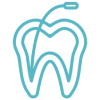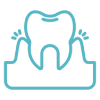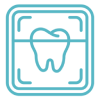
Digital smile design is the process of taking intraoral and extraoral photographs of the patient and taking measurements of their teeth and planning a personalized smile in a digital environment.
When designing a smile, anatomical parameters such as the patient's facial proportions, teeth size, gum levels, pupil position, nose tip, facial asymmetry, lip position, jaw closing relationships, as well as parameters that affect the patient's social life such as age, profession, and gender are taken into consideration.
The most important advantage of smile design is that the patient can see the smile specially prepared for him/her without any dental work. This session is very beneficial for both the patient and the doctor. Thanks to smile design, it is seen to what extent the patient's aesthetic expectations and anatomy match. In addition, it is seen whether this smile changes the patient's speech and the chewing function of his/her teeth.
Things to consider after smile design:
Oral Hygiene: Oral hygiene should be taken care of after treatment and regular tooth brushing habits should be maintained.
Routine Check-ups: Regular check-ups recommended by the dentist should be performed, and in case of any problems, a doctor should be consulted without delay.
Smile design is usually completed in three sessions. However, the duration may vary depending on the scope of the procedures and the patient's specific needs.
Dental implants are titanium artificial tooth roots placed in the jawbone to restore the function and aesthetics of lost teeth and provide oral rehabilitation.
Implant planning and prosthesis application can be made in accordance with many treatment options, from a single missing tooth to complete jaw edentulism. A single porcelain or zirconium crown can be placed on the implants or partial or full palatal prostheses can be applied.
Today, a wide variety of bone augmentation methods are used. These can be in the form of bone powder, artificial bone in the form of blocks or pieces, or bone supplements can be made with bones taken from the patient's own body.
There is no such thing as an expiration date for dental implants. As a general rule, the healthier your natural teeth, the better your oral hygiene and oral health, the longer your implants will stay in your mouth. In case of insufficient oral hygiene, the life of your implants will be shorter than expected.
First of all, a panoramic x-ray and, if necessary, a 3D image (Tomography) should be taken and it should be decided whether your bone is suitable for the implant. Afterwards, the most appropriate prosthetic planning can be made for you and the implants can be placed into the bone.
If there is no problem with your bone level, the implant crown or prosthesis can be made 2 months after the implants are placed. Its construction also takes an average of 1 week.
On the day the implant is placed in the bone, you should apply ice compresses as described, take the prescribed medications regularly and avoid excessive smoking.
Crown and bridge prostheses, known as veneers, are prostheses that surround the teeth on the teeth. Especially in teeth with large fillings, it protects the tooth from external factors by wrapping the entire tooth and allows it to be used for a longer period of time.
Lamina application is a type of prosthesis made by removing very little (0.3_0.5 mm) or no material from the teeth in patients with the right indication and appropriate tooth alignment. However, if there is crowding in the tooth alignment, it may be necessary to remove a little more than the average amount of material from the tooth surface.
Crown and bridge prostheses, known as veneers, are a type of prosthesis made by reducing and abrading the teeth. After this process, it is normal to feel cold sensitivity, especially during the use of temporary prostheses, until the crown and bridge prostheses are permanently bonded. This usually goes away when the permanent crown or bridge prosthesis is attached.
This happens when removable or fixed dentures are fitted to completely edentulous individuals or when prosthetic changes are made to the front teeth. If a correct prosthesis suitable for the person is made, speech is restored within 1 week and maximum 10 days.
The average construction time for prosthetic treatments is 1 week.
Brushing and flossing are essential for oral and dental health. Since the teeth are joined together in bridge systems, you should use an interdental brush since you cannot clean between them with a thread. Since there may be bumps on the palates during the adaptation process of removable prostheses to the mouth, the painful places should be abraded through the prosthesis. In this way, the process of getting used to the prosthesis should be easier. It should not be a mistake to be patient with painful places in order to get used to them and cause serious punctures. Of course, wrong practices such as cracking nuts and walnuts, which we should not do in our natural teeth, also apply to veneers and prostheses.
- Normal and surgical extractions of teeth
- Impacted tooth operations
- Implant placement
- Wisdom tooth operation
- Reconstruction of jaw cysts and tumors operations
- Preprosthetic surgery operations
- Surgical treatment of maxillofacial fractures
- Orthognathic surgery operations
- Operations/treatments related to the maxillofacial region such as jaw joint operations are performed.
Sinuses are the air spaces between the bones of the head.
When our teeth under our sinuses are extracted, the sinus floor sags towards the extraction cavity over time and the bone volume in this area decreases. This bone is insufficient for the implants that we want to place precisely in the bone. The surgical elevation of the sinus floor to increase the reduced bone ratio is called sinus lifting.
t takes about half an hour with local anesthesia.
After the operation, mild pain that can be relieved with painkillers may occur.
Avoid airplane travel for 2-3 weeks, avoid baths or very hot baths, do not dive, do not sneeze hard or make sure that the mouth is open when sneezing. Ice compress application should be continued for 48 hours, every 10 minutes.
In order for the graft applied to the area to become hard tissue, the area has a healing period of 5-6 months.
If there is enough bone height in the jawbone under the elevated part (minimum 3 - 5 mm) for the implants to be firmly attached to the bone, implants can also be placed in the same session.
It is a technique used in the extraction of teeth that cannot be easily seen in the mouth, broken at the gingival margin or impacted teeth. In some cases, there may be bone on the tooth that needs to be removed. The tooth to be extracted may need to be removed after being divided into sections. In this case, surgical extraction is also applied. The procedure can be performed under local anesthesia as in normal extraction.
Tooth brushing should start as soon as the baby's first teeth erupt in the mouth. With the help of gauze or a finger brush, teeth should be wiped by wetting without using paste until the age of 2. Between 2 and 3 years of age, fluorine-free toothpastes should be used, and fluorine-containing toothpastes should be used from the age of 3.
Milk teeth begin to erupt in the mouth during infancy and complete their eruption at about 2 - 2.5 years of age. There are milk teeth that remain in the mouth until the age of 11 - 12 until the permanent dentition period with various intervals. Decaying deciduous teeth must be treated according to the position of the permanent tooth coming from below. Otherwise, the decay will progress, the child will feel pain, and then it will become infected, which will affect the structure of the permanent tooth coming from below.
The roots of the milk teeth begin to erode as the permanent tooth below begins to erupt. The first teeth to change are usually the front teeth in the lower jaw, the permanent teeth start to erupt from the back of the milk tooth from the tongue. It comes forward with the effect of the tongue. It shakes the milk tooth and dissolves its root; the milk tooth falls out, this is a natural process; it does not cause crowding on its own. However, if the permanent teeth are well established in the mouth and the deciduous teeth remain in the mouth without shaking, then extraction of the deciduous teeth is necessary.
The more you can protect your child from harmful external factors, the more you can prevent them from breaking a tooth. School and garden accidents happen a lot, especially in primary school, and especially the upper front teeth that have erupted in the mouth at that age are exposed to trauma. So much so that the teeth may even come out of their place in the jaw. In such a case, a dentist should be consulted immediately. The broken piece can be kept in milk.
The American Orthodontic Association recommends that children be examined by an orthodontist before the age of 7 for early detection of orthodontic problems. At this time, there is a sufficient number of permanent teeth for the orthodontist to determine the presence or potential for a problem. In addition, the need for orthodontic treatment can be reduced with preventive or preventive treatments with early examination. Some orthodontic problems can be easily corrected when diagnosed early.
The ideal age range for orthodontic treatment is 9-13 years old, which includes the growth and development period of children. With the growth that continues at these ages, it is possible to treat jaw problems, and the jaws and face can be harmonized by changing the direction of growth. In addition, healthy teeth can be moved at any age with modern mechanics used in orthodontic treatment. Orthodontic treatment can be performed at any age when the tissues surrounding the teeth are healthy.
In a study conducted by the American Orthodontic Association, the average duration of orthodontic treatment was reported as 22 months. The duration of treatment varies between 6 months and 30 months depending on the difficulty of the problem and patient cooperation. The patient's regular follow-up appointments, the orthodontist's recommendations regarding the treatment and good oral hygiene will help the treatment to be completed on time.
It is generally recommended to avoid hard, crunchy, sticky, sugary and acidic foods. Crunchy foods such as popcorn or chips can break orthodontic appliances and prolong treatment time. Sticky foods such as chewing gum or caramel can easily stick to the brackets and cause tooth decay. It is also necessary to avoid sugary and acidic foods in order to keep our teeth healthy and strong after the braces are removed.
With the advancement of technology in orthodontics, orthodontic bands and brackets have been reduced in size and designed to be less uncomfortable for the patient. With the newly developed braces, treatment is carried out by applying light forces to the teeth, which eliminates the problems caused by heavy forces. Compared to the past, treatment time has also been shortened with new mechanics. Despite the advances in orthodontic treatment, the patient may experience pain and discomfort for a few days when the brackets are first fitted and after follow-up appointments. During this period, moderate painkillers and covering sharp corners with patient wax will help to alleviate the pain.
Once treatment is started, follow-up appointments should be made between 4-6 weeks. Follow-up appointments are of great importance for the progress of the treatment.
The most important part of the treatment is the reinforcement treatment applied after the teeth are straightened. When the brackets are removed, you will start using a removable or fixed retainer, depending on your orthodontist's preference. These appliances will help to maintain the new position of your teeth and help the muscles and tissues to adapt to this position. It is important to use the braces regularly and for the recommended periods of time in order not to change the position of your teeth.
Whitening is a reliable treatment that has been practiced for a long time. It may cause sensitivity that may last 24-48 hours after application. However, this is temporary and choosing the pastes recommended by your dentist or applying fluoride if your dentist deems it necessary will eliminate the sensitivity in a shorter time.
Generally, 2 applications of 20 minutes in one session provide the desired result. However, teeth with excessive discoloration may require several sessions one week apart. The effect of whitening can last between 6 months and 2 years, depending on the patients' diet and oral hygiene habits.
Porcelain laminates are suitable for patients who have gaps in their teeth, have mild crowding, have discoloration that cannot be achieved with whitening, and are not satisfied with the size and form of their teeth. What should be considered after porcelain lamina? Porcelain laminated teeth can be used as before with routine oral and dental care. However, biting very hard foods should be avoided and habits such as clenching teeth and nail biting should be paid attention to and prevented.
Porcelain laminated teeth can be used as before with routine oral and dental care. However, biting very hard foods should be avoided and habits such as clenching teeth and nail biting should be paid attention to and prevented.
It is the process of cleaning the infected tissue residues in the inflamed and root part of the tooth. After the canals are disinfected, canal filling is performed.
If a correct and healthy root canal treatment has been performed on the tooth and the patient pays attention to oral care, the duration of the tooth in the mouth is no different from a normal tooth.
In cases where root canal treatment fails, surgical intervention can be performed at the root end of the tooth or extraction of the tooth should be considered.
Depending on the patient's oral hygiene, the tooth may become infected again in cases where bacteria leak back into the root canals due to reasons such as the formation of a new decay in the tooth or disruption of the edge harmony in the filling of the tooth.
The duration of treatment varies individually depending on the cause of the patient's condition and how much of the TMJ is affected. Depending on the severity of the TMJ involvement, the treatment may last for a few months or may include control and follow-up processes lasting for many years.
In recent years, it has been found that the use of hard splints rather than soft splints offers a more effective solution for TMJ disorders. Hard aligners provide more accurate and clear occlusal contacts. In addition, with the additional material placed on the hard aligners, occlusal forces that do not show a correct distribution as a result of missing or crowded teeth can be easily adjusted.
In order to get effective results, a minimum of 8 hours of daily use is recommended. Generally, this period can be easily completed with night use.
After TMJ treatment, your complaints such as pain and functional limitation may improve depending on the type of TMJ involvement, but the 'clicking' sound that patients usually complain about does not always go away. Despite all this, it should not be forgotten that this condition is recurrent. Stress-induced bruxism is the etiology of many TMJ disorders. Therefore, you should come for regular check-ups and if the condition recurs, you should contact your doctor again.
First of all, X-rays should be taken and a good examination should be done and the dentist should be convinced that there is no dental problem. In inflammation of the sinus cavities located in the upper jaw bone (Sinusitis), our patients may experience pain like toothache. In this case, your Dentist should refer you to an ENT Specialist for diagnosis and treatment of sinusitis
Yes, it interferes. First of all, you should be examined by an ENT specialist, if there is no problem in your ear as a result of the examination, especially toothaches in the lower jaw are reflected in the ear on that side and appear as ear pain. The relief of your earache will be realized with your dental treatment.
Pits, which we call abrasions on the teeth near the root, occur for two reasons. Either from brushing hard or from grinding your teeth at night during sleep. You should give up hard brushing and switch to a soft brush. If you grind your teeth at night, most of the time our patients cannot understand this themselves because grinding is a condition that occurs in deep sleep. Only people lying nearby can notice it. If the cause is grinding, you should use a night plate that you will wear during sleep and will be made by your dentist.
The pits at the bottom of your teeth can be restored with aesthetic fillings.
The lower jaw makes movements such as up and down, left and right thanks to our jaw joint. With a healthy joint socket and fluid, these movements take place silently. When the integrity of the joint is damaged, you start to hear noises from the joint. Damage to the joint can occur for several reasons. Highly made fillings, veneer-style restorations, long-term lack of back teeth, traumas such as blows to the jaw cause the natural integrity of the jaw joint to be disrupted and sounds to emerge. For the treatment of this, you should consult a TMJ (Tempora Mandibular Joint) Specialist.
Send Message Now









































